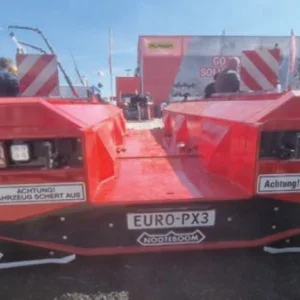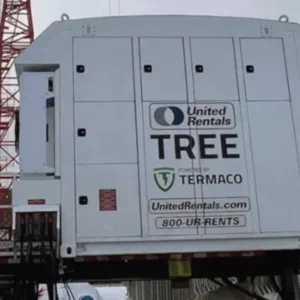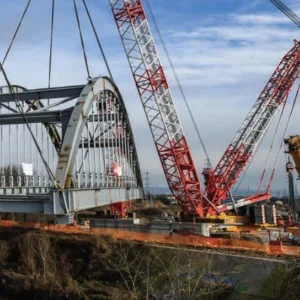Trento Provincial Government in northern Italy recently commissioned a road bridge over the A22 Brennero motorway, linking the Milan-Rome motorway to the Austrian border. The province’s department of public works, transport and networks, headed by Raffael De Col, was responsible for the project, including the installation of a new bridge on the SP235 road, which connects Trento with the Val di Non.
A key demand was to minimise traffic disruption on the motorway under the bridge. Fagioli Group was called in by the bridge’s constructor (Cordioli of Verona) to install the bridge.
The two bridge sections, weighing 1,250t (1,377 US tons) and measuring 114m (473ft) long, 23m wide and 5.3m high, were assembled parallel to the existing traffic, in staging areas on either side of the motorway. They were built on temporary 13m high tubular metal towers and welded together. The parts had been transported to the worksite by conventional means and lifted into place to form the two main sections.
Marco Galli, sales manager of Consorzio Sollevamenti e Trasporti (Milan) coordinated the lifting work, carried out for Cordioli by three of CST’s member companies, who provided the cranes: a Demag TC 3000 (Midolini) and two six-axle Liebherr LTM 1300s (Vernazza and Zanoletti).
Fagioli was responsible for the rotation, alignment and positioning of the sections, carried out on the night of 28 June. The extensive work before installation involved physical movement and stability studies, and risk assessments of possibilities as unlikely as a vehicle accidentally running off the road and on to the worksite. Reports were issued to all parties, including Autostrada del Brennero (the motorway company).
All the Fagioli operations of engineering, calculation and coordination were carried out by project engineer Andrea Massera (chief of Fagioli’s engineering department), assisted on site by Matteo Brugnoli and Alberto Cavatorta. Umberto Sozzi was the heavy transport supervisor in change of the four groups of SPMT modules used to move the bridge sections, a 122 axles line combination of Scheuerle and Cometto units.
Fagioli mounted a custom-built metal substructure, and a cross beam that came into contact with the underside of the bridge section, on each SPMT group.
Each group of SPMTs was manoeuvred by a singlen operator with a joystick remote control. Sozzi was the only person authorised to give instructions to the operators during manoeuvres. The steering movements were pre-programmed in the SPMTs electronics. When precisely in place under the bridge sections, the SPMTs were raised using their hydraulic suspension system.
A three-day weather forecast had to be taken into consideration, as heavy rain could have compromised the terrain’s working conditions. Maximum acceptable wind speed was 16m/s (52ft/s). Maximum movement speed of the SPMTs was 0.8kph.
Fagioli was able to lift and position the sections within a few millimetres, enabling the welding of the connection points and the final joint of the two sections. The horizontal level of the SPMTs was constantly monitored, to keep within a tolerance of +/-0.5°.
The entire operation required only a single night’s road closure. The actual rotation and positioning operations carried out by the Fagioli team began immediately at 10pm and took about four hours, with the SPMTs being removed after the entire weight of the bridge sections had been completely lowered on to the permanent concrete piers.??






